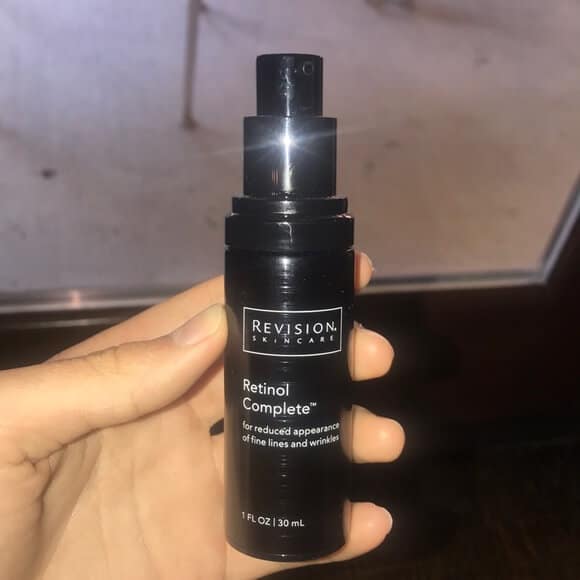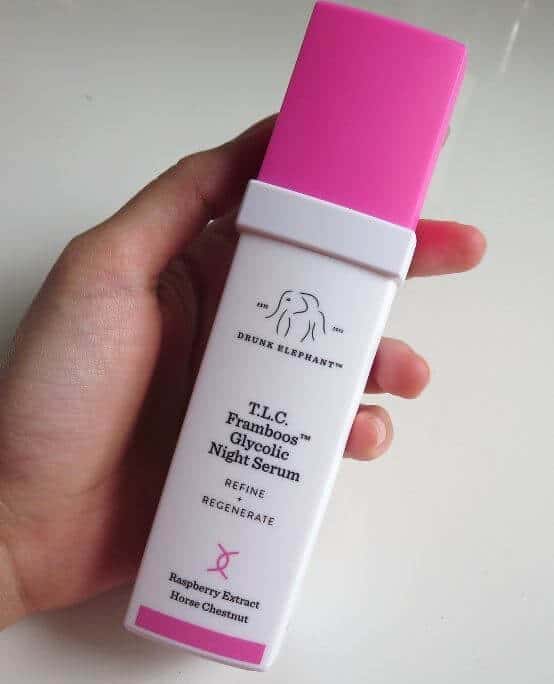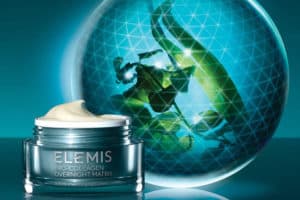Glycolic acid and retinol are the two main components found in many anti-aging skincare products. Both ingredients promise to reduce your wrinkles, acne, hyperpigmentation, fine lines, and other visible signs of aging and make your skin firmer and elastic. But which is better, retinol or glycolic acid?
Glycolic acid, in contrast to retinol, is considered the milder ingredient that can clear your acne and brighten your skin. Retin-A, a form of prescribed retinol, will be recommended by your dermatologist if necessary in your case.
Read on to learn more about retinol and glycolic acid, including which is better for you.
Also, for an excellent product with retinol, take a look at our top pick, the Revision Skincare Retinol Complete:
Click here to see it on Amazon.
Which Is Better Retinol or Glycolic Acid?
Dermatologists recommend applying acid to help you revitalize your skin. A study conducted by Bernardo et al. (2015) published by BioMed Research International found that retinoic acid, a metabolite of Vitamin A1, is more effective in the cell renewal and exfoliation process regardless of the formula.
On the other hand, glycolic acid delivers better results when included in gel and gel-cream formulations.
Murad Alam, the president of the American Society for Dermatological Surgery, stated that retinol is “the best studied and most-evidence-backed topical medication for reducing the visible signs of aging due to sun exposure.”
Benefits of Retinol for Skin

Even though retinol is a quite famous skincare ingredient, only a few know how retinol works, what it does to your skin, how it is applied, its wonderful effects, and if it is suited for all skin types, as well as its side effects. So, read on to know more about retinol.
Retinol is derived from Vitamin A. The difference between the retinol infused in your favorite skin care products and the prescribed ones is that the latter is stronger and will likely deliver a noticeable change in your skin faster.
The reason behind this is the prescribed retinol already contains its activated form-retinoic acid, whereas retinol from the non-prescribed alternatives still has to undergo a process where it will be converted to retinoic acid on the cellular level.
Prescription-strength formulations of retinol include tretinoin (brand names include Retin-A, Atralin, Renova), tazarotene (Tazorac), and adapalene (Differin).
Retinol is very good for people with mature type skin, but younger people can start using this product, especially if they want to address problems such as repairing damage from the sun (hyperpigmentation), reducing fine lines, minimizing pores, acne, chicken skin, and improving their skin’s overall texture.
Take note that Vitamin A obtained from drinking or eating dietary supplements will not give you the effects discussed.
Retinol is known for promoting the removal of dead skin cells and replacing them with newer ones, and stimulating the production of collagen and elastin (helps make your skin firm), both of which slow down as we age. Retinol also inhibits the enzyme that breaks down your collagen.
Most people believe that retinol causes your skin to become thin, but the opposite is true. While retinol frees your skin from dead skin cells, which causes peeling, it also produces collagen and elastin, which thickens and makes your skin firm.
As a result, retinol gives you hydrated and smoother skin without hyperpigmentation. This acid, however, is not recommended for women who are pregnant or currently breastfeeding their babies or those with eczema, rosacea, or psoriasis.
Retinol is best applied at night because vitamin A derivatives tend to break down when exposed to sunlight, making them ineffective. This is also the reason why retinol is usually packaged or bottled in an opaque container to protect the product from the sun’s damage.
At night, before applying retinol, clean and dry your face first. You only need a pea-sized of either the prescribed retinol or the product with retinol every week, especially if you just recently discovered retinol and just want to try it.
Products with retinol will take about three to six months to take effect, while a better result can be achieved by prescribed retinol in six to eight weeks.
For a highly effective yet gentle retinol product, try the Revision Skincare Retinol Complete. This powerful serum contains 5 antioxidants and plant botanicals that boost the effect of the retinol.
Click here to see it on Amazon.
Start by using this product once or twice a week, and then you can increase your use if your skin doesn’t show any sign of irritation.
This retinol product is highly effective at minimizing wrinkles, fine lines, as well as making your skin look brighter and more youthful.
If you applied retinol (either prescribed or infused in skincare products) for the first time and you experienced extreme irritation, then this might be a sign that you put too much on your face. Adjust the amount of retinol next time; allow your skin to adjust and breathe.
If you think your skin improved in tolerating retinol, then that’s the only time you can apply retinol more frequently.
To completely reap the benefits of retinol, make sure to moisturize your skin, avoid peels, physical scrubs, products with benzoyl peroxide, salicylic acid, and resorcinol, and wear sunscreen. Wearing sunscreen is recommended since being exposed to UV light can inhibit the effectiveness of retinol.
Some people believe that if they’re applying retinol on their face, this makes them susceptible to photo-allergy, photo-toxicity, and sunburn, but this claim has no evidence.
Take note that retinol should not be mixed with glycolic acid, salicylic acid, or vitamin C since skin irritation may result.
Peeling, redness, itching, dryness, and flaking of skin are some of the side effects that people may likely experience after using retinol, but these effects will go away after a couple of weeks.
People with oily skin can apply retinol every day, but people with dry or combination skin should only apply retinol one to three times a week. The redness can be treated with anti-inflammatories.
If you think you are experiencing too much peeling and redness, it is better if you consult your dermatologist.
Check out the below video to learn more about Retinol and if it is right for you:
Benefits of Glycolic Acid for Skin

Glycolic acid, which is coined as the “holy grail of acids,” is the most popular among alpha hydroxy acids (AHAs).
Glycolic acid, the smallest and simplest (in terms of structure) of all the alpha-hydroxy acids (AHAs), is a water-soluble molecule, which means that it can easily penetrate your skin to bring the change that you want your skin to have.
The said acid is derived from naturally occurring plants such as sugar cane, pineapple, sugar beets, and citrus fruits. Glycolic acid is present in skincare products in different percentages or concentrations.
Creams and lotions with glycolic acid promote new skin cell production by helping release dead skin cells that are attached to the surface of your skin.
This mode of action by glycolic acid allows your skin to better absorb other products, such as peptides or serums. In addition to this, glycolic acid like retinol also stimulates the production of collagen and elastin, leaving you with firmer and more elastic skin.
Glycolic acid is also usually coined as a chemical exfoliator. By releasing the skin’s dead cells, fine lines, irregular pigmentation, dull complexion, pores, and age spots will be reduced and prevented.
Meaning, if you want to achieve glowing skin and revive your tired-looking skin, glycolic acid is good for you.
Glycolic acid can also dry up pimples, heal acne scars faster, improve discoloration, prevent ingrown hairs (red bumps in the armpit), improve your skin’s texture, and reduce chicken skin (keratosis pilaris) and hyperkeratosis.
Glycolic acid is able to do this by breaking down the sebum (oil), makeup, and dirt present on your skin; in effect, your pore shrinks.
At night, after cleansing is the best time to apply glycolic acid. The benefits of glycolic acid can be enjoyed by almost all skin types but especially those with oily and acne-prone skin.
Glycolic acid can dry your skin, so if you have naturally dry skin, you may opt to use lower percentages (5%) of glycolic acid. A 10% glycolic acid or higher should be used with caution or used only when your dermatologist suggested.
For first-time users, I suggest you start with low percentages at first, then increase the concentration if you think your skin has already adjusted. Irritation and sensitivity are the possible side-effects of this acid. Thus, using sunscreen is recommended before you go out in the morning.
My favorite glycolic acid skin care product is the Drunk Elephant T.L.C. Framboos Glycolic Night Serum:
Click here to see it on Amazon.
It is a 12% AHA/BHA night serum that makes the skin look firmer, brighter, and have fewer wrinkles the next morning. It is gentle, not burning the skin or making it peel. It’s best to use it every other night at first and see how your skin reacts.
Conclusion – Which Is Better: Retinol or Glycolic Acid?
Which is better: retinol or glycolic acid? Retinol and glycolic acid both play a role in making your skin appear young. If you want a quick-go-to and milder ingredient as compared to retinol that will make your skin radiant and free from both acne and dead skin cells, then glycolic acid is the better choice for you.
Glycolic acid offers the same results as the other chemicals but in a gentle manner. However, if you want to completely control your acne, improve the overall texture of your skin by stimulating your skin cells to produce collagen and elastin, then retinol is the best choice for you.
It is possible to utilize both acids at the same time. You can alternately use retinol and glycolic acid, but this also depends on the severity of your skin condition. To be safe, consult your dermatologist so that you can have an accurate solution for your skin condition.
Related reading:
Can You Use Glycolic Acid and Retinol Together?
Can You Use Glycolic Acid and Vitamin C Together?
Can You Use Glycolic Acid and Salicylic Acid Together?









